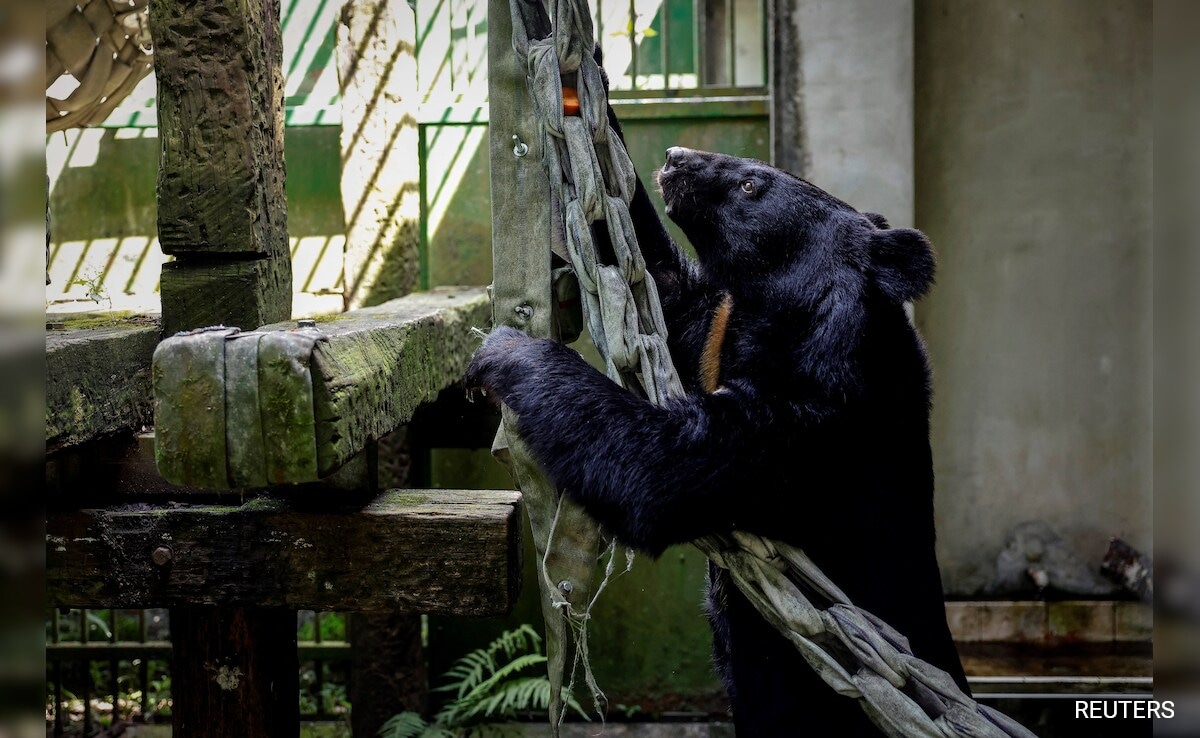The Formosan black bear is one of seven subspecies of the Asiatic black bear, vulnerable to extinction.
Taichung, Taiwan:
As the cage containing an endangered Formosan black bear swung open, conservationists fired gunshots and air horns to ensure the frightened young bear quickly disappeared into the mountains of central Taiwan, hopefully far from human contact.
Ziman, a year-and-a-half-old bear, had finally recovered from the amputation of a leg caused by a hunter’s steel noose and was now given a second chance at life.
“Please take care of him and help him find his parents safely,” Pihao Payen, the leader of a nearby Atayal ethnic community, said in a prayer as Ziman disappeared from view.
Wearing a traditional tribal tunic and headdress decorated with animal horns, the 74-year-old chief and an experienced hunter also prayed for his ancestors’ help in keeping Ziman away from traps.
Taiwanese hunters and conservationists are working together to protect the Formosan black bear, of which only a few hundred are estimated to remain in the wild, by designing new traps that do not amputate limbs if accidentally caught in a snare.
Although bears are not a target for native Taiwanese hunters, people in Pihao Payen’s village accidentally captured bears twice in recent years while setting traps for prey such as deer and boar, a traditional practice in indigenous culture.
According to the non-governmental organization, the Taiwan Black Bear Conservation Association, 18 bears have been caught in traps since 2014, six of which were found dead.
While most bears were released, some suffered serious injuries caused by old-fashioned hunting tools, such as metal snares, which can break bones or cut off paws or toes if the bear struggles to break free.
“Steel snares bounce off the ground and tighten their limbs when activated by animals,” said Liu Li-wen, a zookeeper who oversaw Ziman’s recovery at a government-run bear sanctuary in the mountains of Taichung.
“The snares became tighter and tighter as the animal struggled. When blood circulation stopped, its entire paw became necrotic,” she said, showing photos of Ziman’s swollen left paw. Vets had to cut off most of the leg to save the cub’s life after two months of treatment.
“That’s why we see a lot of bears in the wild with broken legs or toes. It’s likely they got caught in traps, extricated themselves and survived,” she said.
NEW STRINGS
The Formosan black bear is one of seven subspecies of the Asiatic black bear considered vulnerable to extinction by the International Union for Conservation of Nature.
The Formosan black bear is native to subtropical Taiwan and has an iconic V-shaped white spot on its chest. He is seen as a symbol of Taiwanese identity that champions diverse culture and freedom. Democratic Taiwan was previously better known internationally as Formosa.
To reduce death or injury to wildlife, the Forestry and Nature Conservation Agency is now urging hunters and farmers to adopt a new type of animal trap, designed to catch only smaller prey and which does not pull tight until the point of amputation.
More than 5,600 such traps have been given for free to hunters and farmers in mountainous Taiwan, which is 60% covered by forest, while cash rewards are given to those who report cases of bears being caught by traps.
“Because of its small size and because the bear’s palm is very wide, you can see that it (the bear’s paw) will not completely collapse if he steps on it like this,” explains Pan Wen-ming, an ethnic Amis hunter and guava farmer. in central Taiwan as he demonstrated to Reuters reporters how to set up the new trap.
“It tries to minimize injuries while still allowing our tribe’s elders and hunters to hunt prey,” he said.
Chen Yen-long, head of the Wushikeng bear sanctuary in Taichung, said some hunters killed snare bears for fear of being prosecuted for capturing a protected animal.
Sadly, Ziman, the cub with the amputated leg, was found dead in the central mountains just weeks after his release, with authorities unable to determine the cause of death.
“This is not the end of the story. We will not stop what we are doing,” said Lai Chiao Ling, one of Ziman’s caregivers. “At least there are still bears in the wild that we can save.”
(Except for the headline, this story has not been edited by NDTV staff and is published from a syndicated feed.)












